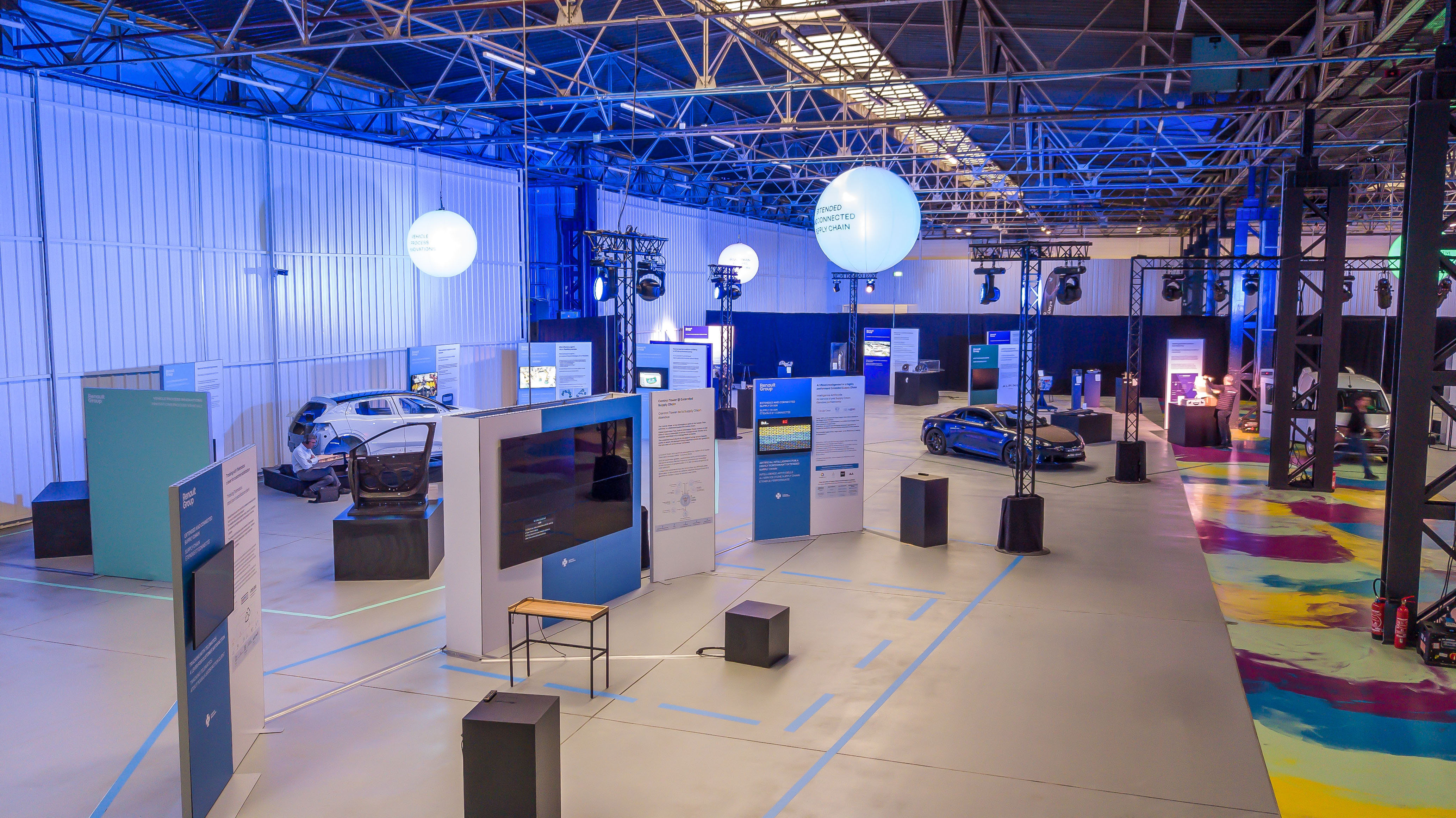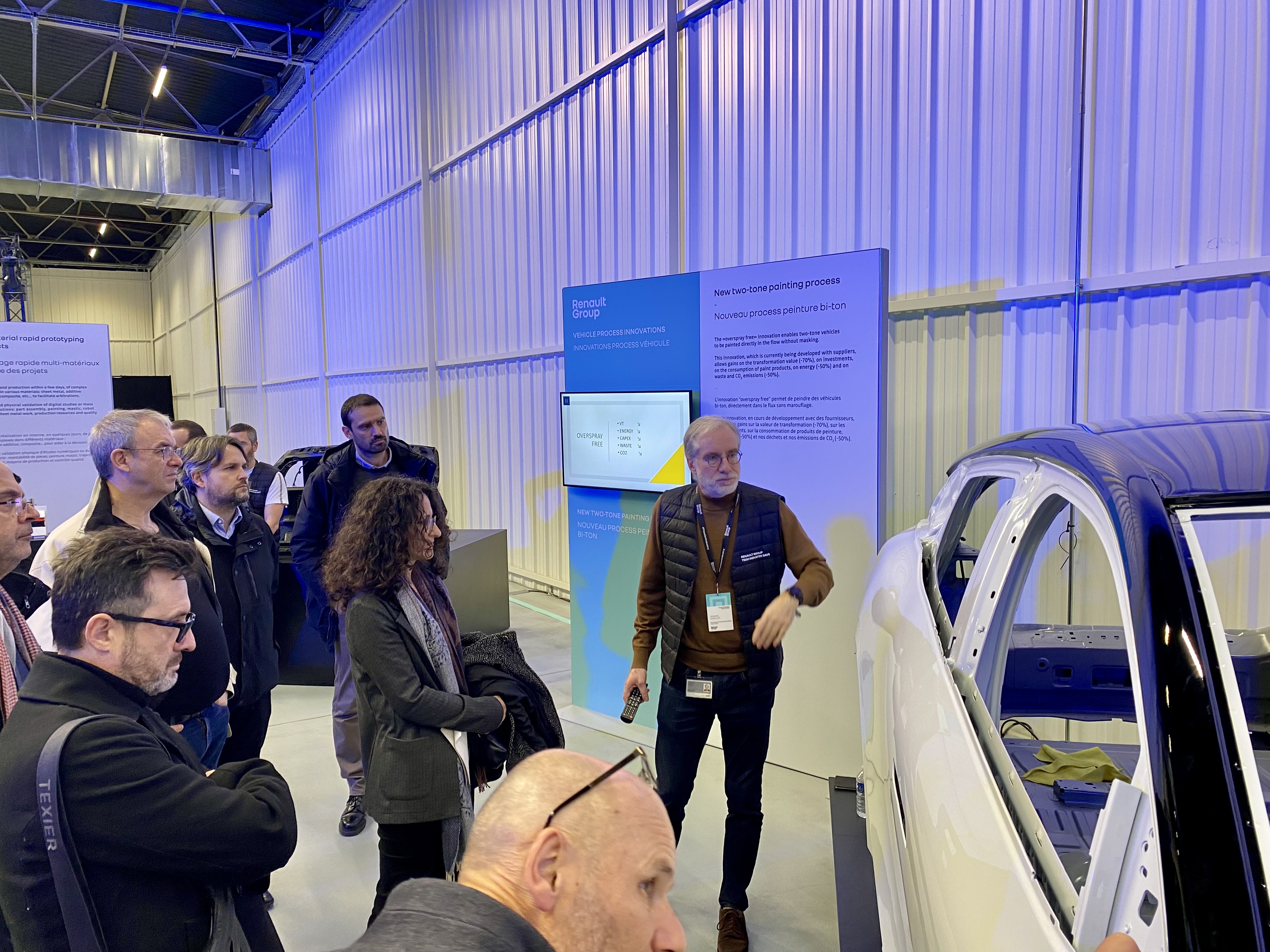Renault Group
Tech Industry
Days
#PassionIndustry



An invitation to discover how Renault Group visualizes and synchronizes the operation of all its factories and its supply chain in real time: the encounter between the physical and the virtual world to improve performance!
In an environment that is becoming more complex by the day, the global reading offered by the Metaverse has many benefits, such as better visibility and a way to understand faster and therefore anticipate.
Supervision of our operations allows us to act in the right place and in real time, thus reducing costs and increasing the quality of our production system and supply chain. This supervision also means prevention and agility in order to adapt to unforeseen events or hazards.
Similarly, this supervision is key in our approach to decarbonizing our sites and reducing our energy consumption.
Convergence of technologies, openness to digital technology at the service of people, the virtues of the Metaverse are demonstrated in this exhibition by concrete examples.


1.1 The industrial data platform developed by Renault Group:
IDM4.0
Renault Group has developed an in-house platform, IDM4.0 (Industrial Data Management
Platform
4.0), which opens the door to the collect of all of our industrial data. This solution for
collecting and standardizing data allows us to control our processes and restore data from
our
industrial equipment on a standard basis and on a large scale.
Stored in the Cloud (Google Cloud), this data feeds the industrial Metaverse, and
allows us to correct or improve our production process in real time.
Today, more than 70% of our industrial equipment is connected.
The supervision of our equipment has allowed, for example, since 2019, a detection of 300
alerts
and the avoidance of production stoppages.

1.2 The ID@Scale industrial data platform: our partnership with
Atos
Renault Group value-generating industrial data acquisition solution is also benefiting other
companies. Our solution is marketed through our partnership with Atos.
Named ID@Scale, ATOS commercializes it and supports companies in their digital
transformation.
2.1 Artificial intelligence to serve production teams
AI makes life easier for operators in their daily tasks and allows production actors to
focus on
higher value-added tasks. AI applications are user-centered and help decision making.

2.2 AI for remote vision control
Thanks to a partnership between Google Cloud and Renault Group in AI, an image data
management
platform has been developed. This platform simplifies vision control. Example of
application:
the Pokaiok wheel concept, developed in collaboration with Buwaei, which allows to ensure
the
regulatory traceability of tires with efficiency and at lower costs.
2.3 Remote vision control
The Cobot function, developed by Renault Group, allows the autonomous operation of a robot
coupled with AI. With a collaborative gripper and a camera function, it automates the
control of
parts and facilitates the work of the operator. The validation of the conformity of the
parts
can thus be done without handling.
2.4 DWS: the operator tablet
The Digital Work Station (DWS) provides the operator with all the information needed for his
workstation and allows him to make requests in real time to his production supervisor.

2.5 CHUET: the production supervisor tablet
The production supervisor tablet (CHUET) allows him to visualize all the events in real
time. He
can thus make the right decisions while remaining close to his work environment.
2.6 Virtual training
Virtual training is an application that allows the link between the mission statement and
the
right operating gestures on video.
2.7 Self Service Big Data for plant users
Self-Service Big Data is an analysis environment on Google Cloud Platform. It collects all
the
product and process analysis data and their context. Thanks to Google Cloud Looker
technology,
the
manager can format them in an intuitive way and analyze them to make the right decisions.
2.8 Renault Virtual Twin (RVT)
RVT is a collaborative backbone enabling to share all product and service data throughout
their
life cycle. It is a unique reference for all the company's businesses.
In the digital continuity of the product, producing a complete digital twin of design,
validation, training and performance is key for every actor involved with the Group.
2.9 Virtual reality in production engineering
The simulations made possible by virtual reality in the industrial digital twin make an
important contribution to industrial performance. They are carried out before the launch of
production tools.
Example of application: study of picking-kitting zones for the validation of ergonomic
conditions.

2.10 Virtual reality in training activities
Immersed in virtual reality, our attention and emotional involvement are four times greater
than
in a traditional training course.
These trainings are quick to deploy and economical in terms of materials and resources.

3.1 Alpine: additive manufacturing for a brand at the cutting edge of
performance
The Alpine brand innovates and offers design parts for small series.
3.2 Inventing industrial additive manufacturing
Renault Group is a member of the HUB 3D Print consortium and, with its partners, is pushing back
the limits of polymer additive manufacturing.
3.3 Polymer additive manufacturing at Flins Refactory
The Flins site has a Polymer Additive Manufacturing center and produces prototypes, tools and
vehicle parts on demand.
3.4 Additive manufacturing for plants efficiency
From tooling production to machine maintenance, the 3D printing centers on the manufacturing
sites respond fastly to manufacturing needs and enable cost and storage reduction.
4.1 Renault Group, pioneer in E-Powertrain manufacturing
Manufacturing of EESM (Electric Excited Synchronous Machine) motors since 2015, motors with
wound rotor
The engines of the future
The support for Cléon team reskilling.


4.4 Renault Group develops a battery with Verkor
Renault Group is working with Verkor to develop and industrialize a battery module for mass
production from 2025.



5.1 Numerical simulation of Body in White accuracy
Today, Autoform software simulates the feasibility of stamping and hemming processes. In the
future, the simulation of the geometry of parts resulting from stamping, assembly and hemming
will make it possible to define compensations on the processes and achieve conformity faster
(e.g.: reduction of adjustment loops on an aluminum hood).

5.2 "Micro-factory spirit", ultra-flexible process
The use of cooperative robots with interchangeable grippers makes it possible to create a
flexible assembly station without jig on the ground.
Among the gains, the optimization of the surface and the investments.

5.3 Thermoplastic tailgate by water injection
Weight is a key driver of vehicle performance. Water injection brings a technological
breakthrough in the design of plastic part. The injection of water creates a hollow rigid body.
It allows, compared to the previous generation of thermoplastic tailgate: a weight gain of 20%,
a saving of 30€ / vehicle.
This patented innovation was developed by Renault Group.

5.4 New two-tone paint process
The "overspray free" innovation makes it possible to paint two-tone vehicles directly in the
manufacturing flow without "marouflage", an operation that consists of camouflaging the part
that is not to be painted. This innovation, which is currently being developed with suppliers,
allows for savings in investments, consumption of paint products, energy (-50%) and reduces our
waste and CO2 emissions (-50%).

5.5 Multi-material rapid prototyping for projects
Thanks to in-house design and production, complex prototype parts are produced in a few days in
different materials: sheet metal, additive manufacturing, composite, etc., to help projects make
the right decision.


6.2 Control Tower of the Extended Supply Chain
The Control Tower is the point of convergence of the Supply Chain professions in a dedicated
space: the Control Room. As a global supervision tool and information flow concentrator, it
alerts in real time of risks or anomalies on all our transports and proposes optimized
crisis
management scenarios thanks to AI.

6.3 Tracking Telematics: an asset for customer satisfaction
Renault Group is one of the very first car manufacturers to collect massive amounts of data
from
its vehicles during transport. The "health" data collected (battery status, tires, etc.)
contributes to maintaining the highest level of quality during transport to the customer.
The analysis of GPS positions at key moments of the transport, with the triggering of
possible
corrective actions, contribute to guarantee the promised delivery date, a major criterion of
our
customers' satisfaction.

7.1 Decarbonization of industry: a lever for energy
independence
Renault Group is committed to becoming Net Zero Carbon by 2025 for the ElectriCity division
and
the Cléon plant, by 2030 for manufacturing sites in Europe, and by 2050 for all industrial
facilities worldwide. The Group has embarked on a very ambitious plan to decarbonize and
make
its industry energy independent, with the aim of achieving a 50% renewable energy mix in
France
by 2026 and 100% by 2030.
7.2 ECOGY energy portal, a key element in energy efficiency
In 2022, Renault Group will migrate its energy portal to a more agile and connected solution
on
the Google Cloud Platform. An ambitious plan to deploy connected energy meters will enable
precise monitoring of consumption at the level of a manufacturing plant.
7.3 Real-time consumption: everyone involved in energy
savings
In order to accelerate collective awareness and optimize energy consumption (residual
consumption when the plant is shut down), instantaneous consumption data (gas and
electricity)
is made available to the company's operational players.


